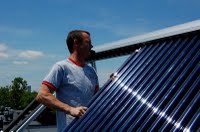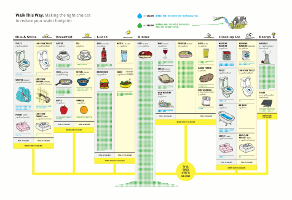 A few weeks ago Paul Rogers of the Mercury News wrote that despite the general perception that the current administration having accomplished relatively little Obama has in fact made major strides in national environmental policy. Some examples not included in the article are: the significant tightening of the previously weak regulations surrounding non-conventionally raised livestock, and the FTC’s stepping up efforts to address greenwashing amidst increasing complaints
A few weeks ago Paul Rogers of the Mercury News wrote that despite the general perception that the current administration having accomplished relatively little Obama has in fact made major strides in national environmental policy. Some examples not included in the article are: the significant tightening of the previously weak regulations surrounding non-conventionally raised livestock, and the FTC’s stepping up efforts to address greenwashing amidst increasing complaints
and problems such as the bogus “bamboo” textiles.
Category Archives: Green Products
How accurate is your “green perception”?
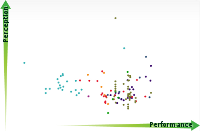 A New Scientist report highlights the dramatic differences between consumers’ perception of a company’s “greenness” and reality.
A New Scientist report highlights the dramatic differences between consumers’ perception of a company’s “greenness” and reality.
New Scientist investigated consumer perception via a 2008 Earthsense survey of consumer ratings, and compared those numbers to each company’s Trucost score, the estimated cost of its environmental impact as a percentage of its annual revenue. The resulting infographic is striking: you can see a clear divide between consumer perception and real performance of certain companies.
A few examples which standout are potentially perceived as being greener than they are Discovery Communications, whose environment-focused television programming probably influences consumer opinions, and Whole Foods Market, although the article defends them by pointing out that they haven’t yet released all of their emissions data.
On the flip side, some companies rated by consumers as not being environmentally friendly actually have higher green ratings. Ebay, Nike, and brewer SABMiller were three business that scored relatively high environmental ratings in their respective sectors, but consumer rankings show that they do not project their performance to the public well. Some, such as Nike, nay still be suffering from the bad PR they suffered in the ’90s.
Converting to a Dual-Flush Toilet
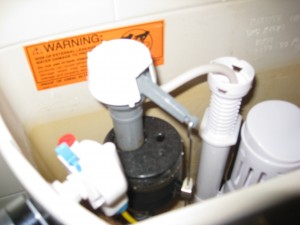 No, we didn’t get a new toilet. We converted our old one with a One2flush kit. Turning the handle one way makes a half flush and turning it the other makes a full flush. And it’s easy to increase or decrease the water levels of both of them if necessary by adjusting the settings on the flapper.
No, we didn’t get a new toilet. We converted our old one with a One2flush kit. Turning the handle one way makes a half flush and turning it the other makes a full flush. And it’s easy to increase or decrease the water levels of both of them if necessary by adjusting the settings on the flapper.
Our toilet was already a modern, low-flow toilet, using just 1.6 gallons of water per flush. But you really don’t need 1.6 gallons for every flush. That’s now the default setting for the full flush, and 0.8 gallons is the default setting for the half flush, but we’ll have to continue playing around with the water levels to figure out what’s the least amount that we can use.
The kit was relatively simple to install—you can tell by the fact that two very non-handy people did it without flooding the bathroom. Taking the toilet tank off was obviously terrifying, and a little difficult, too, because the bolts were corroded. But this video walked us through the whole thing step by step.
We did run into one problem when we were done. The fill valve continued to allow a steady trickle of water through, even when the tank was already full. We were afraid we’d have to replace the whole fill valve (or shamefacedly ask our landlord to do it), but cleaning the valve did the trick.
The problem? The previous tenants had put bricks in the toilet tank to save water. The bricks had started to degrade in the water, and brick dust had gotten into the valve. This is why people now emphasize that if you want to displace water in your toilet, use a bottle of water—don’t use [unprotected] bricks!
Cross-posted on pragmaticenvironmentalism.comThe Least Toxic Way to Melt Snow & Ice

We had the season’s first real snowstorm this weekend, and we weren’t really prepared for it. I didn’t even know where our shovel was! We also didn’t have any salt for the front steps, so I took this opportunity to find out if we could get something that had less of an impact on the environment.
From what I can tell, there’s no truly environmentally friendly way to melt snow and ice. The two main materials people use—rock salt and calcium chloride—are both bad; it’s really just a choice of which is better. Along with many others, the City of Cambridge recommends using calcium chloride rather than rock salt or sand. (Ironically, the city also provides rock salt free of charge.) Many de-icers are a combination of multiple ingredients, so check the label. Here’s what I could find in local stores:
Rock Salt – NaCl (Sodium Chloride)
- toxic to plants and animals in high concentrations
- increases salinity of waterways
- corrosive to metal
- works best at temperatures above 20 degrees Fahrenheit
Magnesium Chloride – MgCl
- similar to calcium chloride below, but generally a liquid or additive to other de-icers (often rock salt)
- increases salinity of waterways
- less corrosive than rock salt
Calcium Chloride – CaCl2
- only half as much is needed (a handful per three square yards)
- works better than rock salt at temperatures below 20 degrees Fahrenheit
- increases salinity of waterways
Urea – (NH2)2CO
- adds ammonia to waterways
- increases algae blooms (much like fertilizer)
- works best at temperatures above 20 degrees Fahrenheit
Sand (Or Kitty Litter, Ashes, etc.)
- clogs sewers
- increases sedimentation in streams
- increases turbidity, reducing water quality and potentially killing fish and aquatic plants
- makes hard ice more slippery
- doesn’t melt ice
Calcium magnesium acetate and potassium acetate are two promising de-icers, but they’re generally only available for large-scale use or as additives to rock salt.
Since all ice melters have adverse effects on the environment, the best thing we can do is use less of them. To me, this means that calcium chloride is the way to go. It’s more effective in smaller amounts, and, if I could find the colored kind (I couldn’t around here), I’d be able to see the coverage and use less of it.
Keep in mind that these compounds are not supposed to take the place of shoveling, but break up the ice so we can shovel it away and prevent more skin from forming. That crunch under your feet is an indication that someone used waaay too much.
Cross-posted on pragmaticenvironmentalism.comSustainable (sea)food
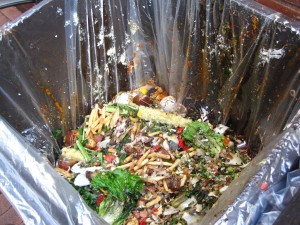
New Scientist has an interesting article on the “Five eco-crimes we commit everyday.” Most are not very surprising, but the details are interesting, such as the fact that the western world wastes one third of its food!
Egregious as this waste is, the means used to produce and procure much of our food is more important. To this end, Slash Food has a brief post highlighting some better seafood choices including local award-winning business Aqua Australis.
Also released this past week, a study of food sustainability revealing that, surprise of surprises, the devil is in the details and “food miles” are an over-simplification.
Vacuum Tube Solar Hot Water Comes to Cambridge
One of the first home improvements Rachel and I made when we purchased our condo here in Cambridge this spring was a solar hot water installation on our rooftop.
The system we had put in uses vacuum tubes, a newer, more efficient type of solar collector than the black box flat panels of old. As a writer covering energy and the environment in Cambridge and China, I’d spent the past three years tracing this new and exotic technology back to the factories and cities in China where they are surprisingly commonplace.
I first read about the tubes three years ago in a story in the Boston Globe. A family in Newbury, MA was using a massive installation to provide hot water and heat for their giant barn of a house. A photo that went with the story showed their installation covered in frost on a cold winter day. Somehow, despite the cold, the tubes were still kicking out 120 to 160 degree water.
 The secret behind vacuum tubes that allows them to work just as well in winter as summer is, just as their name suggests, a vacuum space. The diagram at the right shows how the tubes work. Sunlight passes through a clear outer glass tube and travels through an evacuated space or vacuum where all of the air has been sucked out. The sunlight passes through this vacuum and then hits an inner black pipe that absorbs the sun’s rays converting the sunlight to heat. What’s key about all of this is that whereas light rays can pass through a vacuum space, heat can not. All of the heat is therefore trapped inside by this highly efficient, transparent insulator.
The secret behind vacuum tubes that allows them to work just as well in winter as summer is, just as their name suggests, a vacuum space. The diagram at the right shows how the tubes work. Sunlight passes through a clear outer glass tube and travels through an evacuated space or vacuum where all of the air has been sucked out. The sunlight passes through this vacuum and then hits an inner black pipe that absorbs the sun’s rays converting the sunlight to heat. What’s key about all of this is that whereas light rays can pass through a vacuum space, heat can not. All of the heat is therefore trapped inside by this highly efficient, transparent insulator.

After I read the story in the Globe I found out that there are thousands of factories kicking out these tubes in China and roughly 1 in 10 Chinese people use them for their hot water.
Six months after first hearing of the tubes, I toured the R&D center of one of these factories in Beijing for a story I wrote for New Scientist.
The story also led me to Rizhao, a city on the coast between Beijing and Shanghai where 99 percent of residents get their hot water from the sun. Here is a video I made from a rooftop of the city while talking with Rizhao’s mayor, Li Zhaoqian.
By the time we had a chance to buy a place of our own I was totally sold on the technology and couldn’t wait to put the tubes in on our own place. Evacuated tubes are still hard to come by in the US, however, and most of the installers I spoke with insisted they were no better than the flat panel solar collectors that had been around since the 70s. The estimates I got for flat panel installations, however, were twice the size of what I figured I could get by with using vacuum tubes. Then I found Bruce, a contractor with New England Solar Hot Water, who, like his company’s name suggests, only does solar hot water installations. Bruce and his crew had been doing vacuum tube installs for years and were stoked to hear I’d actually toured some of the factories where they get their parts.

In mid June they installed the collectors shown on the right that heat all of our domestic hot water; the water we use for showers, laundry, and in our sinks. The system is backed up by natural gas but on a sunny day like today, its unlikely we’ll need it. At 9am, with an outside temp of 43 F, our tubes are already a toasty 95 F and climbing.
Living Green Made Easy
 The counter culture revolution germinated the civil rights and the peace movements, but also inspired the first Whole Earth Catalog (1968) that offered ways to live an environmentally conscious life. In its latest publication, the Whole Green Catalog, provides a wide range of products and living green tips for the eco-conscious or curious. The Whole Green Catalog is chock full of the usual green resources on housing, transportation, cleaning products, and healthy eating but also delves into greening your art and the latest in eco-technology. The catalog is published by Rodale, an eco-publishers that believes in “healthy living on a healthy planet”.
The counter culture revolution germinated the civil rights and the peace movements, but also inspired the first Whole Earth Catalog (1968) that offered ways to live an environmentally conscious life. In its latest publication, the Whole Green Catalog, provides a wide range of products and living green tips for the eco-conscious or curious. The Whole Green Catalog is chock full of the usual green resources on housing, transportation, cleaning products, and healthy eating but also delves into greening your art and the latest in eco-technology. The catalog is published by Rodale, an eco-publishers that believes in “healthy living on a healthy planet”.
This is an excellent resource to have at home for easy reference, but I also recommend checking out some online resources to green living:
Smart Grid = Smart Appliances
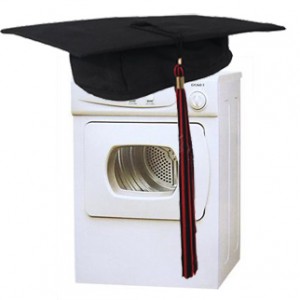 Yesterday’s New York Times carried an article about appliance maker Whirlpool, who was the recipient of a $20 million grant from the Federal Government to fund product development in the rapidly developing field of smart appliances.
Yesterday’s New York Times carried an article about appliance maker Whirlpool, who was the recipient of a $20 million grant from the Federal Government to fund product development in the rapidly developing field of smart appliances.
These devices, once connected to a Smart Grid-enabled electricity supply, will be able to receive information from the grid and cycle down their power demands during times of peak energy use (and higher costs per kWh). At the moment, they are anticipating savings of $40 per year for a standard size dryer.
As always, your mileage may vary.
Next in the Smart Grid appliance pipeline, General Electric Co. will soon roll out its first commercial smart appliance, a hybrid electric heat pump water heater. The company said the pump will save consumers $250 a year in energy costs.
Other “demand response” appliances expected within the next year are refrigerators able to delay defrost cycles and dishwashers that delay operation until energy demands and costs decline at night.
The Federal Energy Regulatory Commission estimates smart grid-enhanced home appliances could shave up to 7 percent off U.S. peak demand through 2019. When this is added to the 15% reduction in demand that Smart Grid monitoring devices have been able to achieve in field testing, we have within our grasp the ability to reduce electricity consumption by 20% without making any structural changes within our homes.
Weighing in on electric cars
 A recent issue of The Energy Report, featured a story about a new Michigan factory to supply batteries for the Chevy Volt and other vehicles in GM’s fleet. The Energy Report covers Energy and Environmental policy in the United States and globally on CleanSkies.com, a relatively new webcast.
A recent issue of The Energy Report, featured a story about a new Michigan factory to supply batteries for the Chevy Volt and other vehicles in GM’s fleet. The Energy Report covers Energy and Environmental policy in the United States and globally on CleanSkies.com, a relatively new webcast.
While the article touts the benefits of getting higher mileage and lower CO2 emitting vehicles, we must keep in mind a few costs before running out to buy a new electric car (be it from GM, Daimler-Chrysler, or Tesla Motors). These costs include environmental, financial, and and the opportunity costs for using your money for other purposes.
Electric cars do have an impact on the environment, related to the extraction, manufacture, use, and disposal of the materials in their batteries; as well as the rest of the car. Tesla Motors does seem to be conscientious of its environmental impact and other car manufacturers like Toyota and Honda are promoting battery recycling. Because electricity must be created to charge the batteries, whether electricity comes from coal or nuclear, or wind, solar, or hydro, hybrid cars makes a substantial difference on one’s carbon footprint. Manufacturing an entire car has a huge environmental impact as well, particularly when compared to using mass transit, car sharing programs, occasional car rentals, bicycling, and walking.
Owning a car is very costly in financial terms: car principal payment, interest, gas, maintenance, and insurance. One of the best ways to be a good environmental steward: don’t own a car. Living close to work, school, and shopping nodes keeps money in your pocket, protects the earth’s resources, reduces your carbon emissions, exercises your body, and leads to a healthier life style.
Ghouls & Gallons
Here’s an interesting graphic showing the amount of energy consumed by some common appliances when not in use, although the distinction between “passive” and “active” loads also seems unnecessary and distracting. Also, this phenomenon is typically called phantom load not “vampire load,” as the artist has dubbed it, after a less common term for wall-warts. Perhaps this even inspired google’s little contribution towards energy frugality last Halloween: The Haunted House? In any event, be sure to multiply the listed costs of these little suckers by a factor of 2 or 3 to to more accurately reflect bills in Cambridge.
Also while surfing this weekend I came across another infographic from progressive magazine GOOD. This one’s a sort of decision tree, comparing water consumption for daily activities. Keep in mind though, that things are not quite as simple as some would like to make them out to be. While it may actually take more water to grow an apple, the devil is in the details. If you’re biting into a Jonagold from Stow in September, then much of the water was rain, and very little gasoline went into transporting it. On the other hand, an orange from a field irrigated with scarce water in California or Florida has a lot of embodied energy. As always caveat emptor.

